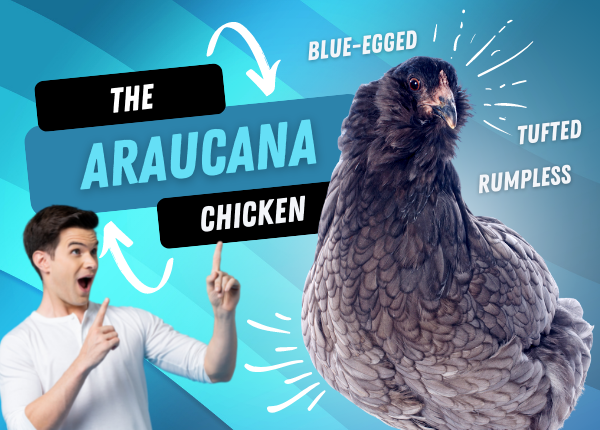
Whilst I adore this quirky little oddball of a bird, the Araucana is a rather troubled designer chicken. The Araucana’s tale (or lack of) is a solid egg-sample of why people don’t always know best when it comes to challenging Mother Nature.
The Araucana was bred to fine-tune the skill of laying unusual blue eggs🪺, but the breed picked up some other quirks along the way. Most of her loopy looks were bred intentionally because the man in charge liked the way they looked, but they had health consequences. Big ones. They’re an absolute nightmare to breed.
Feeling blue about going blue? Don’t let me put you off! These are very special little chickens, and sure they just have their issues, but don’t we all?
Araucanas are inquisitive and comical. They’re friendly, they lay loads and loads of beautiful blue eggs, and they can make great pets.
Araucanas are relatively small chickens, and whilst they’re classed as dual-purpose, what they’re best at is laying those robins-egg-blue eggs.
They’re also constantly confused with Easter Eggers and Ameraucanas because they’re all related and all lay blue eggs.
I’m going to tell you everything you need to know about this loveable chicken, but if you already know what’s hatching your attention then feel free to jump straight to it here. I won’t take offense!
- What Do Araucana Chickens Look Like?
- How To Pronounce Araucana?
- What Are Araucana Chickens Good For?
- Are Araucana Chickens Good Layers?
- Are Araucana Chickens Used for Meat?
- How Long Do Araucana Chickens Live For?
- Which Chicken Breeds Lay Blue Eggs?
- Eggs Taste Better?
- Are Blue Chicken Eggs Low in Cholesterol?
- Araucanas Lay Pink Eggs?
- Are Araucana Chickens Rare?
- What Are Araucana Tufts?
- What Does Rumpless Mean?
- What’s The Difference Between Easter Eggers and Araucana?
- What’s The Difference Between Araucanas and Ameraucanas?
- What Are the Recognized Varieties of Araucana Chickens?
- The Araucana Chicken Breed Standard
- How Big Are Araucana Chickens?
- Can You Get Bantam Araucana Chickens?
- Do Araucana Hens Go Broody?
- Where Did the Araucana and Chicken Come From?
- Where Can I Buy Araucana Chickens?
- Do Araucana Chickens Have Health Issues?
- Are Araucana Chickens Suitable for Beginners?
- Are Araucana Chickens Hardy?
- How To Care for Araucana Chickens
What Do Araucana Chickens Look Like?
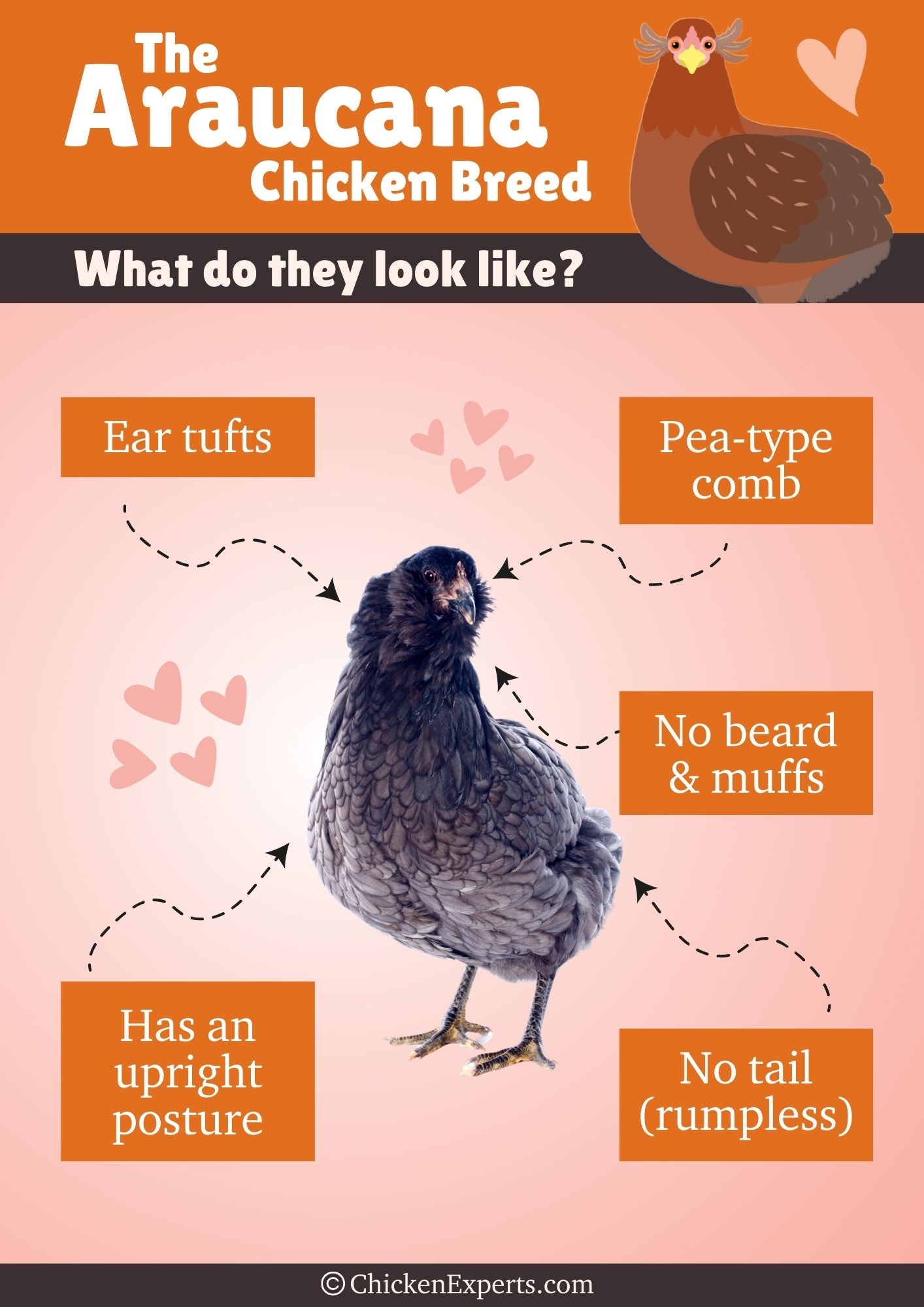
The Araucana is a distinctive-looking chicken and reminds me - in the nicest way possible - of a vertical guineapig.
Some have the facial hair of Doctor Robotnik from Sonic and some look like a Dilophosaurus. They have concave spines that mean they look almost like they’re permanently doing a yoga pose. Oh, and they don’t have any tails.
Sometimes pictures speak louder than words!
How To Pronounce Araucana?
Araucana should be pronounced arrow-caa-na but is commonly pronounced a-roo-car-na.
What Are Araucana Chickens Good For?
It’s all about those blue eggs! Sure, they’re cute in a weird kinda way, but it’s their eggs that make them too cool for school.
Are Araucana Chickens Good Layers?
Araucanas will lay 150 – 250 eggs of those baby-blue beauties a year for you. They’re great layers! Araucanas tend to start to lay at 20-24 weeks old.

Are Araucana Chickens Used for Meat?
Araucanas are dual-purpose chickens, and despite being on the small side they are still utilized for meat because of their plump breasts. It’s mainly a way to make use of retired hens or surplus roosters. There are better meat birds to pick from if it’s a Sunday roast you’re after.
How Long Do Araucana Chickens Live For?
Araucana chickens should be by your side for 6-8 years. It’s a good thing they have great personalities.

Which Chicken Breeds Lay Blue Eggs?
Eight types of chicken lay blue eggs, or seven, if you’re being technically correct:
- The Araucana Chicken
- The Ameraucana Chicken
- Cream Legbar Chickens
- Easter Egg Chicken (also known as Easter Eggers, but not a breed)
- Arkansas Blue Chicken
- Whiting True Blue Chicken
- Lushi Chicken
- Dongxiang Chicken
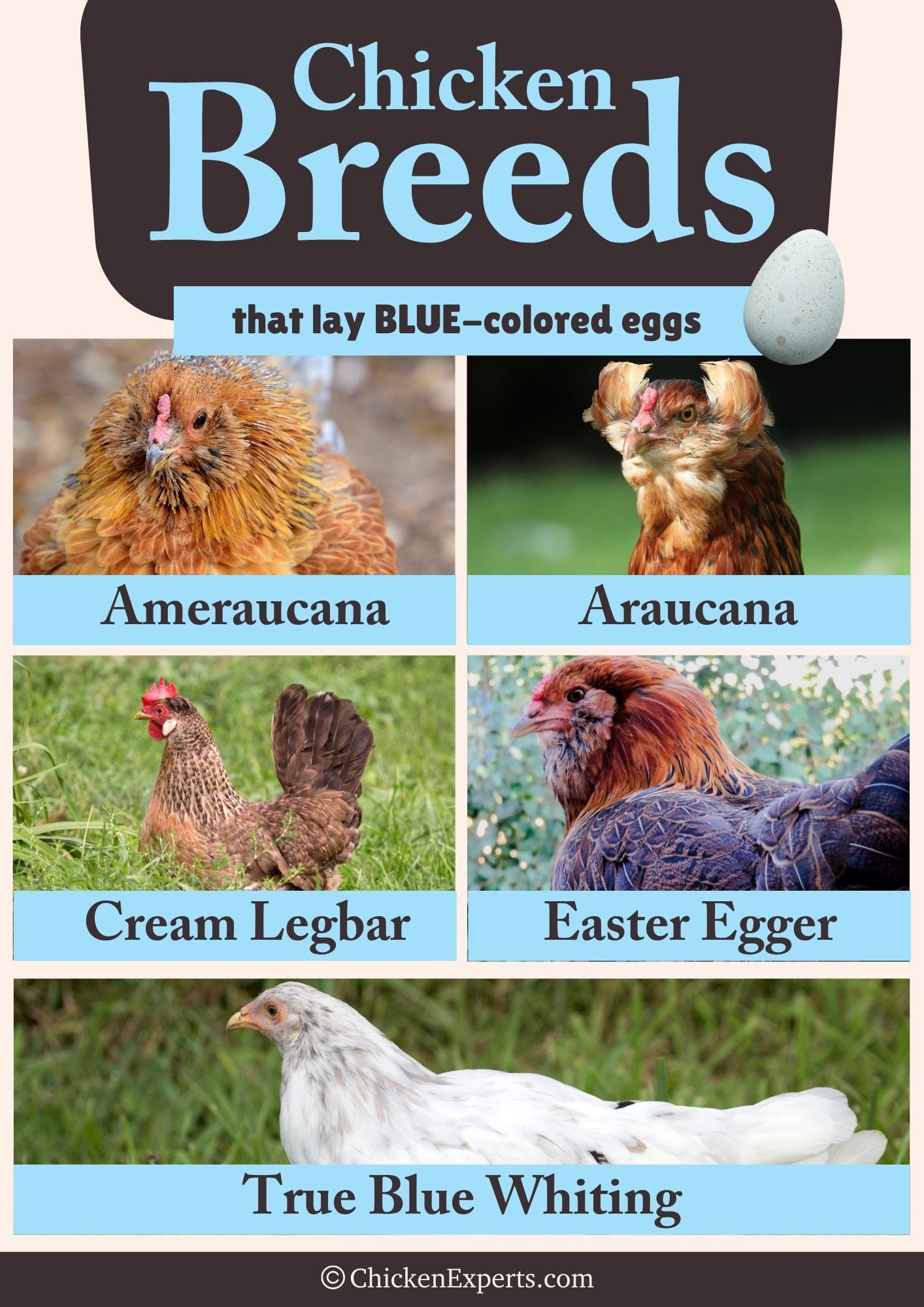
Do Araucana Eggs Taste Better?
There’s no evidence to say that they do. When Araucanas were introduced to America their blue eggs were all the rage. They were thought to be something special – which, to look at they are – but they taste no different from any other egg.
Are Blue Chicken Eggs Low in Cholesterol?
No, it’s a myth. Blue chicken eggs taste the same and have the same nutritional value as any colored egg. Hatcheries once advertised the new and unusual blue eggs as superior, low-cholesterol eggs meaning they could charge more pennies per poultry pop. People soon wised up!
Do Araucanas Lay Pink Eggs?
Araucanas don’t lay pink eggs. If you’re getting pink, then you’ve got an Easter Egger of some sort. True Araucanas only lay green-blue eggs of various shades
Are Araucana Chickens Rare?
True Araucana chickens are very rare. That dodgy gene that humans oh-so-kindly bred into Araucanas means that very few chicks survive the incubation stage. Most chicks that are hatched successfully are not really 100% Araucana (shhh…it’s Mummy hen’s little secret).
“Most breeds get hatch rates of 90%; Araucana breeders get successful hatches of anywhere from 55% to 25%, including the post-hatch period.” (Araucana Club of America)
Araucanas are so hard to breed true, that even the best hatcheries out there have decided to move aside from breeding these birds.
“Due to their poor hatch rate and the difficulty of breeding them to standard conformation, the Araucana breed is extremely rare. Cackle Hatchery® offered Araucanas from 2012-2016 but discontinued them after 4 years. We knew our customers would never be satisfied with this breed. If you want a chicken that lays eggs with blue shells, consider the Ameraucana” (Cackle Hatchery)
What Are Araucana Tufts?
Araucanas have two unique physical traits: they have ear tufts, and they don’t have tails.
These famous ear tufts, or peduncles, sprout out in all shapes and sizes, meaning they give each chicken a quirky, unique look. They grow out of folds of skin which usually grow below the ear called plicae: it’s almost like a mole or skin tag and it exists because of the dodgy gene.
Tufts were intentionally bred into Araucanas by Dr. Reuben Bustos because he just rather liked them! He spotted the quirky face fluff in their predecessors and wanted to make it a feature of his blue-egg-bonanza bird.
The problem is that tufts don’t always grow how or where they are supposed to. Tufts were intended to grow symmetrically, pointing backward from below the ear. Well, that didn’t go to plan.
Tufts don’t always grow on both sides: Araucanas can have non-symmetrical tufts, tufts on one side and not the other, or two or three tufts on one or both sides of their face. If you’re obsessed with symmetry, you might not dig this chick!
Tufts come in all kinds of cool and awkward-look shapes from teardrops and powder puffs to fans and balls.
What Does Rumpless Mean?
Araucanas are rumpless, meaning they are missing their tails, their coccyx, and the last couple of vertebrae in their spines. They’re also missing the uropygial gland at the base of their backs which is used for preening.
The trait was bred purposefully into the Araucana from Collonca chickens, and they were bred to be rumpless as the colonials believed rumpless birds had a better shot at escaping predators with nothing to grab.
Araucanas have an upright stance and their back slopes toward their bottom. It’s a recognizable look that they’re well-known for.
What’s The Difference Between Easter Eggers and Araucana?
Easter Egg chicken is a term given to any hybrid chicken that lays blue eggs, usually amongst other colors. Easter Egg chickens aren’t a breed of bird and tend to be slimmer, less troubled, and look more ‘normal’ than Araucanas. Araucanas only lay blue eggs and are always rumples with tufts.

What’s The Difference Between Araucanas and Ameraucanas?
Araucanas have no tail (or rump) and have fluffy ear tufts called peduncles. The gene that results in ear tufts is an evil little gene that causes very high mortality in embryos. Araucanas aren’t thought to be as friendly as Ameraucanas, but this is possibly because they are raised mainly at hatcheries and don’t get handles as much. They do lay more eggs.
Ameraucanas don’t carry this dangerous gene, so don’t have ear tufts. They always have tails and always have fluffy little beards and muffs, so they look a little bit like chipmunks, and a little bit like hawks. That sounds weirder than it looks. Ameraucana chickens always breed true.
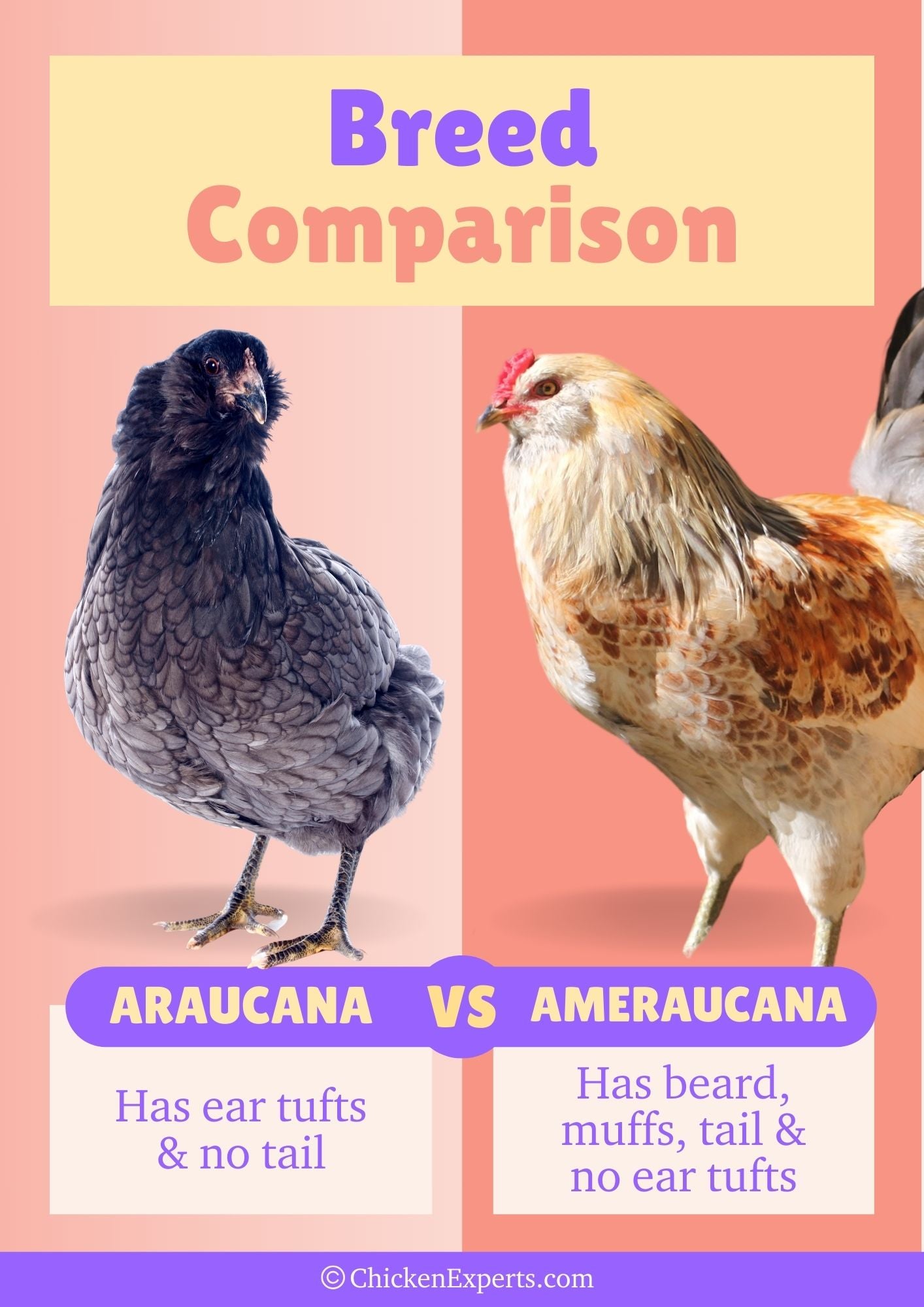
Just like the chickens themselves, the name ‘Ameraucana’ is an amalgamation of America and Araucana. The Americans bred various American chicken breeds with blue-egg-laying chickens to retain the blue egg skills of the Araucana but without the deadly gene.
In America, ‘true’ tufted Araucanas are very rare as their survival rate is very low. Most Araucana chicks that survive only manage to do so because they’re genetically impure…luckily for them! They always produce a mix of tufted and clean-faced chicks.
In the UK and Australia🇦🇺, and quite a few other countries, Araucanas and Ameraucanas are accepted as the same breed: tail or no tail. No wonder this chick stuff scrambles our brains.

What Are the Recognized Varieties of Araucana Chickens?
There are five color varieties of Araucana chicken:
black, black-breasted red, golden duckwing, silver duckwing, and white.
Buff is also recognized in the bantam varieties, and there are lots of distinguishable colors available that aren’t yet recognized.

The Araucana Chicken Breed Standard
Araucanas must have red pea combs, which lay flat to the chicken’s head, be rumples, have ear tufts, and lay only blue eggs. All chickens should be clean-legged and, depending on their color variety, their shanks should be willow, yellow or black. Araucanas should have an upright posture.
How Big Are Araucana Chickens?
Large Fowl Araucana hens are only 4lbs and roosters aren’t much heavier at 5lbs.
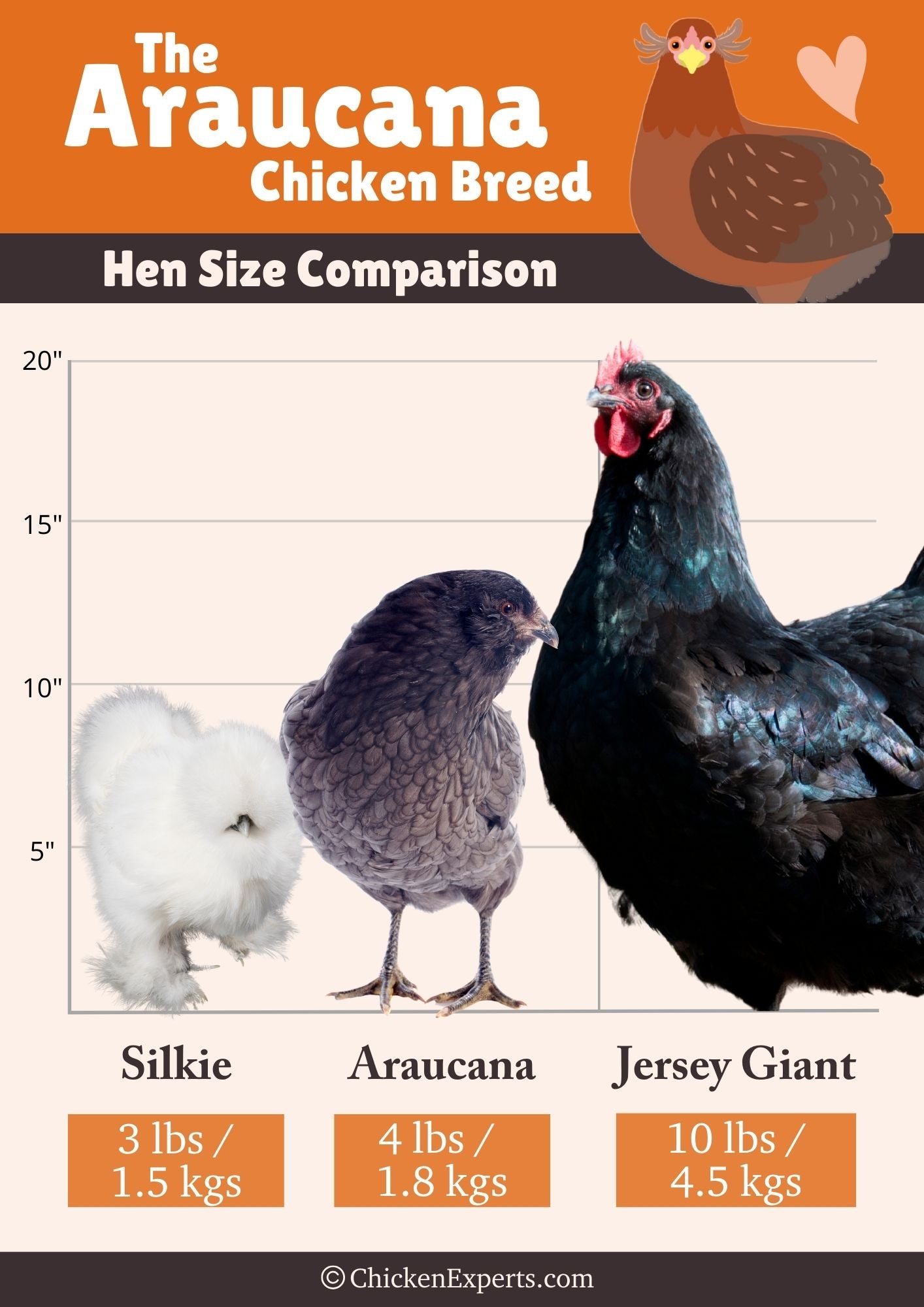

Araucanas are on the smaller side of the chicken scale and can be a little later to bloom in terms of laying eggs. But weirdly, they grow up faster through their teenage years. Your Araucana pullets and cockerels will be head and…well, maybe not tails, above their coop mates.
Can You Get Bantam Araucana Chickens?
Yes! Bantam Araucanas are bound to make you giggle with their cute little upright waddle.
Araucana bantam roosters weigh just 26 ounces and Araucana bantam hens weigh 24 ounces.
Do Araucana Hens Go Broody?
Yeah, they do their very best to hatch those little lovelies, but sadly the survival rate in Araucanas is very low. If you have true Araucanas, you would be very lucky to hatch any successfully. Even the major hatcheries gave up on this breed.
If your baby blues are peeping all over the place, you probably don’t have a true Araucana chick. Sorry.
Where Did the Araucana and Chicken Come From?
The original Araucana was developed by crossing the only two chicken breeds kept by the Mapuche Indians: the Collonco and the Quintero. There’s debate about whether this was a human-interaction situation by the people of Araucanía, a region of Chile, or the two breeds bred naturally.
The Collonco chicken brought the blue eggs and the rumples trait to the party, and the Quetros chicken is responsible for the deadly tuft gene.
Dr. Reuben Bustos was the first to breed Araucanas commercially, and just rather liked these odd traits so decided to home in on them, not realizing the harm they might cause.
Where Can I Buy Araucana Chickens?
True Araucana chicks are so hard to hatch that lots of the well-known hatcheries have had to call it a day, but there are still passionate poultry folk running bespoke hatcheries who are doing all they can to preserve this troubled chicken. You’ll need to get in touch with a specialist breeder like Awesome Araucana or those listed with the Araucana Club of America.
Do Araucana Chickens Have Health Issues?
Araucana chickens have issues, and that’s why they’re a rare breed. don’t have the best odds of surviving incubation as a result of their near-fatal fluffy-ear gene, and even if they do, they have some challenges ahead of them.
“As an additional complication, the rumpless feature interferes with fertility. One of the functions of a chicken’s tail is to pull feathers away from the vent during mating. Rumpless chickens bred for generations gradually develop shorter backs until they can no longer breed naturally.” (Cackle Hatchery)
Are Araucana Chickens Suitable for Beginners?
If you can get your paws on an Araucana chick then chances are you’ll be very happy with your new egg-popper. They’re hardy, don’t mind confinement as long as they get out to exercise, will be delighted if you let them free-range, and seem to be good at dodging danger.
They’re a comical, entertaining breed, who are energetic but docile and can be easily handled if you start them young.
Are Araucana Chickens Hardy?
Araucanas are tough eggs. Whilst they aren’t designed for chilly weather, they’re surprisingly hardy at surviving colder and hotter conditions. They originate from Chile and as they’re spending all their energy-tokens adapting to colder conditions, they won’t lay many eggs through the colder months.
Their flat pea combs aren’t susceptible to frostbite either, which gives them an advantage…finally!
How To Care for Araucana Chickens
Araucana chickens are relatively low maintenance once they’ve made it through their chick days. They do suffer from post-hatch mortality, so you need to be cautious about the stage in their lives that you take them home.
They forage well so don’t need much supplementary feed if you have room for them to peck. They don’t need much room, are hardy, and don’t have any general health issues other than their breeding complications.
They don’t have preen glands, so they are dependent on their beak alone to groom. Just keep a close eye on their feathers for pests and mites.
So, there we have it: the weird and wonderful, rumpless, tufted, blue-egg laying, upright Guinea pig that is the Araucana chicken!
It’s not easy choosing chicks, is it? Picking the right poultry for your coop or your people-pack is tough and can feel daunting. Where to even begin?
Whether you’re an eggs-pert or novice every new addition to your coop needs careful research and lots of thought. Chickenpedia offers some cracking crash courses to walk you through the entire process, from picking your perfect breeds and raising chicks, to managing pests and predator problems.
Once you subscribe, you'll bag yourself access to every single course, all of their go-to guides, unlimited egg-spert advice, and much more. It's a cracker of a find: all the good stuff in easy-to-digest chunks.


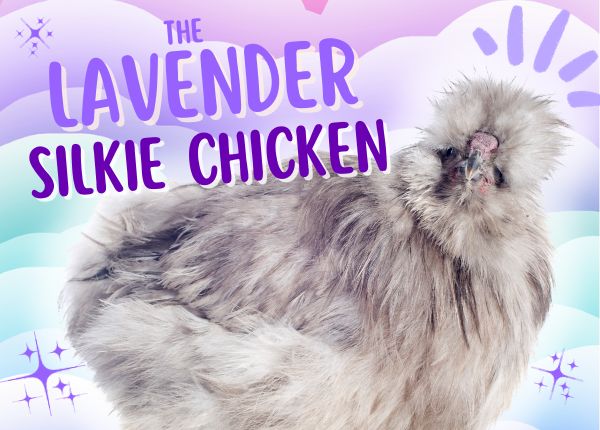
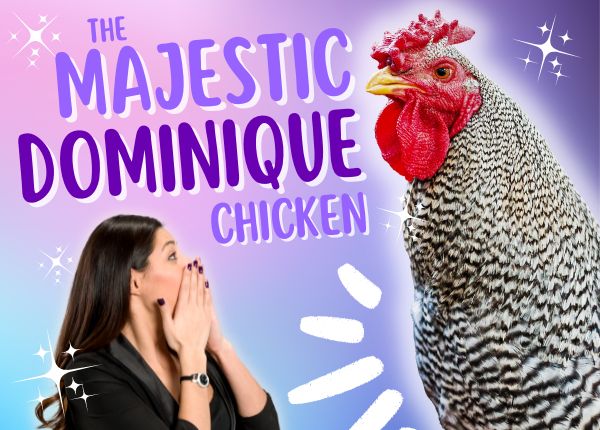







Leave a comment (all fields required)